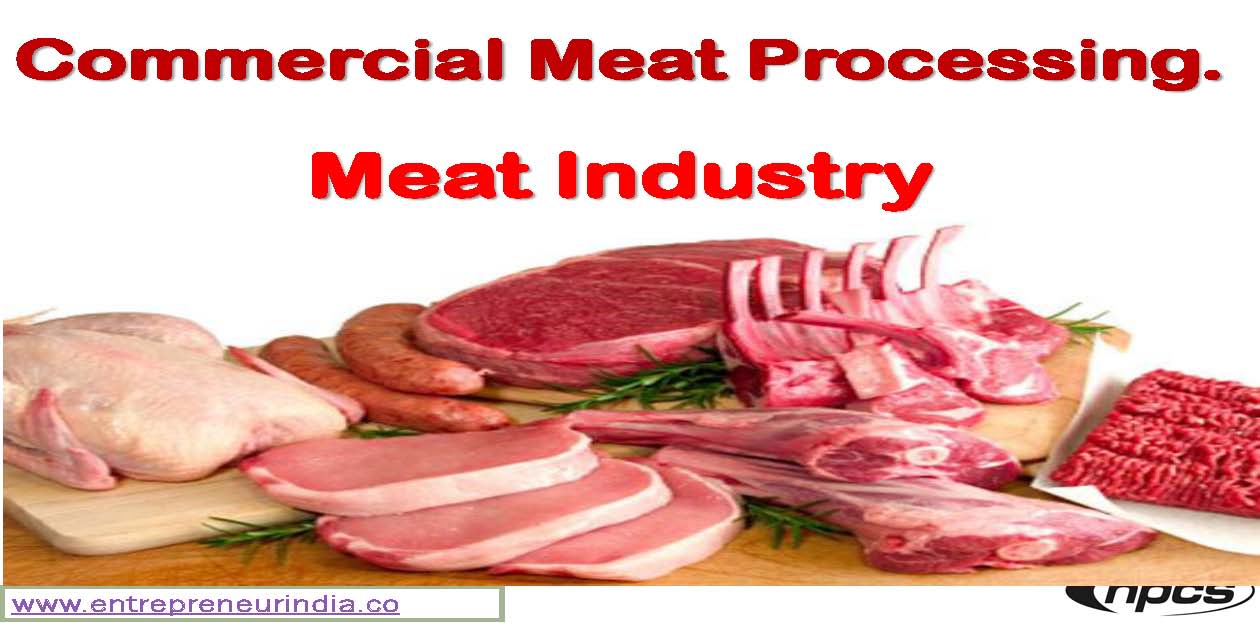
India’s meat industry is evolving rapidly due to rising domestic demand, better cold chain infrastructure, and increased focus on exports. Commercial meat processing. Meat industry operations are no longer limited to local butchers or unorganized units. Entrepreneurs and investors are now tapping into this sector by setting up hygienic, technology-driven meat processing plants. With modern equipment and compliance with food safety norms, these units produce high-quality meat products for retail, food service, and international markets. This article explores opportunities, investment potential, and critical considerations when venturing into commercial meat processing in India.
Opportunities in the Commercial Meat Processing Industry
The meat industry in India is transitioning from traditional practices to modern, integrated processing units. Let’s explore the key sectors and growth drivers.
1. Rising Demand for Processed Meat
India’s growing middle class, changing lifestyles, and urbanization are driving a shift in food preferences. Consumers increasingly prefer packaged and ready-to-cook meat products due to convenience and hygiene.
Top-Selling Processed Products:
-
Chicken nuggets and sausages
-
Marinated meat and kebabs
-
Cooked and frozen meat dishes
Market Trends:
Consumers in metro cities and tier-2 towns seek clean-label, high-protein meat products. As a result, demand for branded processed meat is rising steadily.
See More – Tomato & Fish Waste
2. Export Potential of Indian Meat
India ranks among the largest exporters of buffalo meat globally. Processed meat that meets international standards sees strong demand in Middle Eastern, Southeast Asian, and African markets.
Export-Driven Products Include:
-
Frozen boneless buffalo meat
-
Sheep and goat carcasses
-
Halal-certified meat cuts
Logistics Advantage:
India’s strategic ports and cold storage networks enable smooth exports. Many commercial meat processing plants are located close to ports like Mumbai, Kochi, and Visakhapatnam.
3. Low Investment Entry Options
While large meat processing plants require higher investment, small-scale units and contract manufacturing models offer low-barrier entry points.
Examples of Small-Scale Ventures:
-
Poultry dressing units
-
Cold storage and meat delivery services
-
Local meat packaging and marination centers
Support Schemes:
The government offers financial support through schemes under the Ministry of Food Processing Industries (MoFPI) and Animal Husbandry Infrastructure Development Fund (AHIDF).
4. Types of Meat Processing Units
Depending on your budget and target market, you can choose from a variety of processing plant setups.
Primary Categories:
-
Slaughtering Units: Basic facilities for hygienic slaughter and carcass handling.
-
Processing Plants: Advanced units with freezing, cutting, grinding, and marination capabilities.
-
Value-Added Units: Facilities that produce sausages, meatballs, deli meats, and cooked products.
Choosing the Right Type:
Select your unit based on target customer segments, supply chain access, and regulatory permissions.
5. Essential Equipment & Infrastructure
Setting up a commercial meat processing unit requires specialized equipment to maintain hygiene and comply with food safety standards.
Must-Have Equipment:
-
Slaughtering and evisceration systems
-
Meat mincers and bowl cutters
-
Vacuum packaging and blast freezers
-
Cold storage and refrigerated vans
Infrastructure Needs:
Good road access, water supply, waste treatment units, and proximity to livestock markets are critical.
6. Regulatory Compliance and Licensing
Operating in the meat industry requires strict adherence to hygiene, safety, and animal welfare standards.
Licenses Required:
-
FSSAI registration for food safety compliance
-
Pollution Control Board clearance
-
State Animal Husbandry Department approvals
-
Halal certification (for export and specific domestic markets)
Why It Matters:
Non-compliance can lead to heavy penalties or cancellation of licenses. Regular inspections and quality audits ensure smooth business operations.
7. Profit Margins and Scalability
Processed meat businesses can generate strong profit margins, especially when producing value-added products. Brand building and efficient logistics significantly increase scalability.
Revenue Channels:
-
Wholesale to hotels and restaurants (HoReCa)
-
Modern retail chains and supermarkets
-
Online meat delivery platforms (B2C)
Profit Tip:
Introduce private-label products or white-label for e-commerce brands to scale without additional marketing costs.
Advantages of Investing in Commercial Meat Processing
The meat industry offers several benefits to new entrants:
-
Consistent Demand: Daily household consumption, festivals, and special occasions ensure steady demand.
-
Export Incentives: Government promotes meat exports with incentives and infrastructure support.
-
Employment Generation: Processing units generate rural employment across butchering, transport, and packaging.
-
Technological Upgradation: Affordable automation options increase production efficiency and hygiene.
Also Read – Want to Start Business in Kerala
Challenges and How to Overcome Them
While the opportunity is big, meat processing businesses face some challenges:
-
Cold Chain Gaps: Invest in proper refrigeration at all stages.
-
Skill Shortage: Train workers in hygiene, food safety, and machinery handling.
-
Animal Sourcing: Build reliable relationships with livestock suppliers.
-
Public Perception: Position your brand around hygiene, ethical sourcing, and transparency to gain trust.
Solution:
Partner with training institutes and government agencies for workforce development and technical support.
Conclusion
The commercial meat processing. Meat industry in India holds massive potential for entrepreneurs looking to invest in a growing, profit-rich sector. From small-scale poultry dressing to large export-driven buffalo meat units, the opportunities are diverse and scalable. With rising demand for hygienically packed, value-added meat products, now is the right time to enter this segment. Ensure compliance, invest in the right equipment, and focus on quality and branding to build a trusted meat processing business. Whether you serve the domestic market or tap into exports, success in this industry lies in efficiency, hygiene, and innovation.





